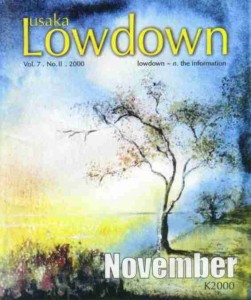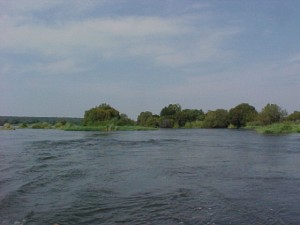 It has been referred to in various travel magazines as “the prettiest lodge on the Zambezi” and at the 25th Annual Awards Ceremony of the Trade Leaders Club in Madrid, Spain, Chundu won the Year 2000 trophy, an International travel award, which was presented by an overseas selection panel from the Tourist, Hotel and catering industry.
It has been referred to in various travel magazines as “the prettiest lodge on the Zambezi” and at the 25th Annual Awards Ceremony of the Trade Leaders Club in Madrid, Spain, Chundu won the Year 2000 trophy, an International travel award, which was presented by an overseas selection panel from the Tourist, Hotel and catering industry.
Although Zambezi Royal Chundu has only been in existence since 1996 it has a certain timelesness about it. It is in the unique position of being in Tribal Trust land and was given the honour of carrying the local Chief, Sekute’s, Royal Family’s name, “Chundu.” Most of the staff at the lodge are from the Tokaleya Tribe. Friendly, kind and extremely patient people.
I had been looking forward to visiting Zambezi Royal Chundu ever since I’d met the owner, Lynne Morze, at a travel show earlier in the year. I thought that with someone as warm and unpretentious as Lynne at the helm, the Lodge in question must surely have the same vibe about it … and it does. We were made to feel thoroughly at home and “part of the family” throughout our stay at Chundu.
With three teenage children in tow, intent on catching the biggest tiger in the Zambezi-above-the-Falls we set out for a brief, but enchanting few days at Chundu in mid July. The Lodge is situated about 59 km from
Livingstone on the Kasangula Road in the Katambora area – close to the Zambian Botswana border post.
The chalets (there are six – two family and four twin) are situated on a rolling lawn and surrounded by a lush flower garden. The river is literally within spitting distance of the lodges – one could almost lie in bed and fish – although the “mozzie’ gauze on the windows might be a problem! In fact this would be even easier from the Treetops river houses which are on the other side of the dining area from the lodges. There are two family units, one sleeping seven and one sleeping four people. They’re built right out onto the Zambezi River under a canopy of massive waterberry trees. Treetops was built with the regional and local markets in mind – with a charge of US$55 D.B.B for adults and US30 for children p.p.p.night. Probably one of the most reasonably priced accommodation establishments of this type on the upper Zambezi. There’s also a very natty bar area and pool behind the lodges… for warmer days.
After a brief recovery from our journey, we were summonsed to dinner by the age-old beat of the African drums. There’s a wonderful ambience in the dining boma. It was built by the community using local materials. It’s spacious but warm. The decor is mostly locally hand crafted, and there are a few huge stunning wildlife paintings on the wall.
On warmer nights, one can stroll along the wooden walkway to a balcony built over the Zambezi and enjoy a sundowner to the accompaniment of the sounds of the burbling river – and some of the many nightjar species in the area. According to bird fundi and Chundu co-owner, Chad Morze, all species of nightjar are found in the Katambora Forests, including the particularly rare Natal nightjar.
Butternut soup with crunchy croutons was the perfect starter for a chilly July evening and this was followed by a delectable creamy lemon chicken dish and fresh vegies and apple pie and cream. I’ve never been partial to Zim wines, so with tongue firmly in cheek I tried a 1997 Zimbabwean Pinotage, that Lynne had recommended, with the meal. Not bad at all, 1997 was definitely a pretty successful year for Zim wines!
And so to bed, to dream of the Zambezi’s famous fearsome fighting fish that we hoped to encounter – once, or twice at least – the next day.
A fishing trip with Chundu does not involve the unpleasant business of getting up at crack of dawn (an almost impossible task for teenagers on holiday). We agreed to embark on our fishing adventure at 8.30 after a thoroughly satisfying hot breakfast.
We set off at a leisurely pace in a fair sized, sailless catamaran, with our guide Solilo. We spotted a few elephant browsing in the distance on the Zimbabwean shoreline and a massive croc slid into the water from one of the islands close by, reminding us that dangling feet over the edge of the boat was not such a great idea. Trawling with Rapala for tiger seemed to be the order of the day. Despite the time of day (and the time of year) we had an extremely successful morning’s fishing catching four good-sized tiger. Chundu, being in a tribal trust land, works on a “catch and release policy”, so after admiring and recording for posterity on camera the exhausted fish, and ecstatic fishermen, we carefully popped our very relieved tigers back into the river. A note to other enthusiastic fishermen – the best time to fish is actually from August through to March (the warmer months). Take your own rods and tackle and don’t think of bringing your own boat. Chundu has a fair supply, and their boat drivers/guides are well trained and excellent.
An alternative to fishing could be a canoeing trip on the river where your personal guide offers assisted paddling whilst you explore the island channels and riverbanks of the Zambezi. A trip to Chobe Game Reserve is another option. It takes no time at all to get through the Botswana border and into the Chobe Game Reserve, and the day includes a game drive, lunch at Gabbies Guest House and a game viewing cruise on the river. There’s also a “Four Countries Ferry Trip” where guests take a trip on a ferry to a point where they can observe four countries’ borders at once – Botswana, Namibia, Zambia and Botswana. Then there’s a Victoria Falls tour; a visit to the Mosi oa Tunya Game Park or Maramba market in Livingstone; bird and island walks; a traditional Makoro trip or a visit to a Tribal African Village. Prices range for each activity and some – like the Tribal Village tour – are free (but a donation to the school would be appreciated).
I was sorry that we didn’t have time to get involved in more activities, but there’s always a next time – and once you’ve had a taste of their wonderful hospitality and savoured the warmth and peace of the Zambezi
Royal Chundu, you’re bound to want to return to this genuine “home from home” on the Zambezi.

Leave a Reply
You must be logged in to post a comment.